
I heard somewhere that the Edmonton Oilers' run to the finals this spring justified a status-quo for the Maple Leafs in the current off-season.
It's true that there have been many parallels between the Oilers and the Leafs in recent years.
Through questionable defensive brigades and problems between the posts, intertwined with undeniable star power on offense, the two clubs have shared many similarities during many of the last off-seasons, during which we wondered when one of the two cores would implode.
Good. Management's confidence in their core led Edmonton to a single Stanley Cup victory. By way of comparison, the Oilers' 15 wins in 2024 represent more than the Maple Leafs' number of playoff victories… in the last four seasons.
Faith hasn't brought the two franchises to the same place.
I guess the logic behind this statement has to do with patience, consistency and confidence. I normally agree with these principles, which suggest that a championship team isn't built in a single season, and that constantly changing the main ingredients only delays the development of the perfect recipe.
That said, this philosophy applies to what you want to perfect from a solid base.
If your mix has too much flour, not enough eggs and a little too much milk, and this is the sixth time you've tried to achieve the consistency of a crêpe… Drop the vanilla essence and the cinnamon, and change your basic proportions .
Common sense
Forgive me for using this slogan, but it seems to me to apply here, from a purely hockey and in no way conservative point of view.
So let's start with common sense, that is, things that can be explained without the need for fancy statistics.
It's obvious that the Oilers' core gave the decision-makers reason to believe. Before reaching the Stanley Cup Final (not the ultimate goal, mind you), Connor McDavid led his team to the Western Final in 2022, only to lose to the champions in the second round in 2023.
The Panthers lost in the final before lifting the trophy. The Golden Knights played in two Final Fours and one Final before becoming champions. The Avalanche had reached the second round in three consecutive seasons before going all the way. And in the case of the Lightning, we're talking about one final, two Final Fours and a tough loss to the Blue Jackets in the first round, before winning back-to-back rings.
Adversity builds character.
One first-round series win in eight years isn't adversity. It's a series of failures that clearly require change.
Very different cores
You'll understand that I don't agree with the statement quoted in the first sentence.
However, it would be interesting to demonstrate this with figures.
First, let's analyze the parties involved: the Oilers' core, and the Maple Leafs' core.
For the purposes of this exercise, let's focus on the offensive base of the recipe. In Toronto, the window opens with the signing of John Tavares in 2018, since accompanied by Auston Matthews, Mitch Marner and William Nylander. In Edmonton, Leon Draisaitl and Ryan Nugent-Hopkins are the only two forwards left from Connor McDavid's rookie year.
1 – Mountains of cash (and what's left of it)
A four-star core earning $46.65 million per season leaves less money on the table – $42.91 million – to build the rest of Toronto's defensive brigade and goaltending tandem.
In Edmonton, the Oilers' three forwards earn $26.5 million per season.
Even if you extrapolate to four players, you're only looking at $35.3 million, more than 10.3 million less than the Leafs. And if extrapolation doesn't do it for you, Zach Hyman earns $5.5 million, giving a figure of $32 million per season for the club's top four forwards.
2 – Does Nuge belong in the conversation?
For those who say that Ryan Nugent-Hopkins is the worst of the seven players mentioned, you should know that over the past 5 years, he has averaged the same points per game (0.92) as John Tavares.
3 – The cream of the crop
Even if RNH is the worst of the seven, the Oilers have the best two of the seven. It's not as if Auston Matthews and Mitch Marner live on the same planet as Connor McDavid and Leon Draisaitl, when it counts.
Over the past five years, Connor McDavid (108 points in 61 games) and Leon Draisaitl (92 points in 61 games) have combined to score 3.27 points per game in the playoffs.
The Leafs' Core Four ? 3.44 points per game. Divided into four, I remind you.
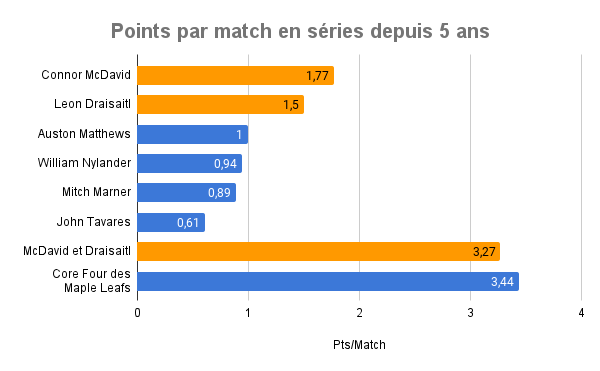
4 – The cream of the crop
It's even worse when it comes to puck distribution.
Connor McDavid (76 assists in 61 games) and Leon Draisaitl (57 assists in 61 games) combined for more assists per game (2.16) than Toronto's top four players (2.09).
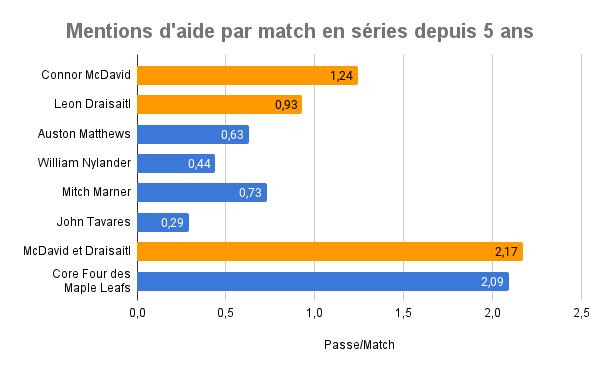
Now add Nugent-Hopkins. The figure swells to 2.83 assists per game.
By distributing the puck, McDavid and Draisaitl (who are capable of scoring 50 or 60 goals if they want to) and Nugent-Hopkins (a natural passer) leave many more chances for complementary players to contribute significantly to the team's success.
In case you had any doubts about the sample, the result is just as revealing in the regular season.
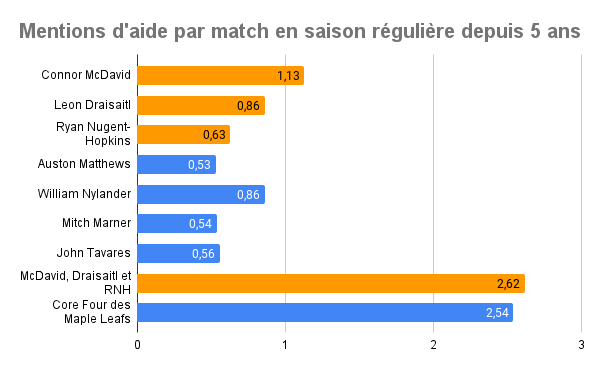
5 – Sharing is key
We're getting close to something.
The Maple Leafs put a lot of pressure on their big guns to score goals. Over the past five seasons, the Core Four has scored more goals than the team's other sixteen regular-season players.
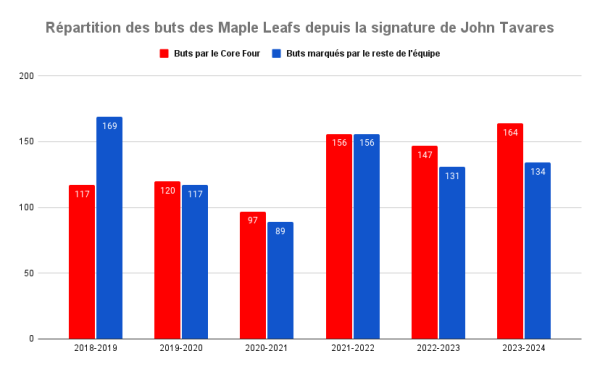
In Edmonton, the McDavid-Draisaitl-RNH line was in a similar position from 2018 to 2023. Between the three of them, they were almost on a par with the Oilers' seventeen other players.
It was in 2023-2024 that the situation changed, as you can see from this graph.
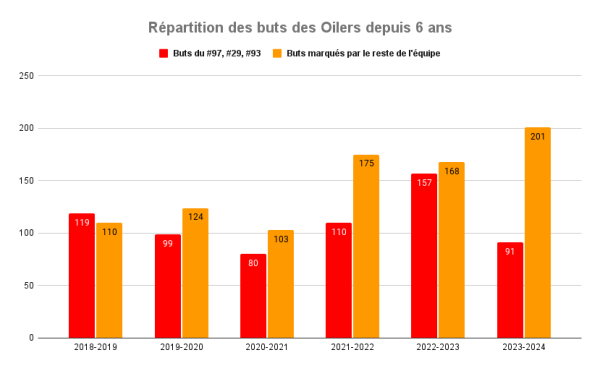
And that's when a complementary player – Zach Hyman, ironically a former Leaf – can get the opportunities he needs to become an impact player who still knows his role.
Let's repeat: McDavid and Draisaitl can win the Maurice-Richard.
They can also make their teammates shine and reach the Stanley Cup Final with the help of complementary players.
Through Connor's legendary point haul over four intense playoff rounds, it's worth noting that he scored just 8 of his team's 86 goals. Even with Leon, the figure is only 18, or 20.1% of total production. Hyman (16), Nugent-Hopkins (7), Bouchard (6), Ekholm (5), Holloway (5), Henrique (4), Kane (4), Janmark (4), McLeod (4), Ceci (2), Brown (2), Nurse (2), Broberg (2), Perry (1) and Kulak (1) contributed a considerable team effort to what they accomplished.
The status-quo
Not only are the proportions of the recipe questionable, in Toronto, the ingredients may not be meant to be mixed together in the same dish.
It's not impossible that they'd have us lie, but it seems obvious that a major change would be the next logical step.
So if Mitch Marner refuses to waive his no-trade clause, Brad Treliving's hands are tied.
And the Oilers story shouldn't be a glimmer of thoughtful hope for the Maple Leafs.
Footnote
It's hard to capture the essence of a team and the reasons behind its successes and failures, given the differences in composition and the balance to be struck between offense, defense and the goalie in front of your net.
The aim of this article, from a more attack-oriented angle, is simply to take a closer look at these two teams, both of which have undergone major rebuilds.